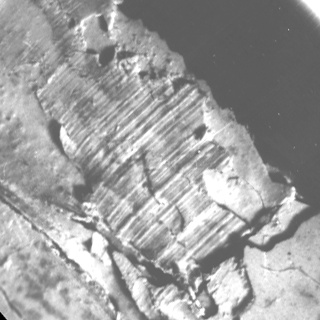1
2
3
4
5
6
7
8
9
10
11
12
13
14
15
16
17
18
19
20
21
22
23
24
25
26
27
28
29
30
31
32
33
34
35
36
37
38
39
40
41
42
43
44
45
46
47
48
49
50
51
52
53
54
55
56
57
58
59
60
61
62
63
64
65
66
67
68
69
70
71
72
73
74
75
76
77
78
79
80
81
82
83
84
85
86
87
88
89
90
91
92
93
94
95
96
97
98
99
100
101
102
103
104
105
106
107
108
109
110
111
112
113
114
115
116
117
118
119
120
121
122
123
124
125
126
127
128
129
130
131
132
133
134
135
136
137
138
|
Anisotropic image segmentation by a gradient structure tensor {#tutorial_anisotropic_image_segmentation_by_a_gst}
==========================
@tableofcontents
@prev_tutorial{tutorial_motion_deblur_filter}
@next_tutorial{tutorial_periodic_noise_removing_filter}
| | |
| -: | :- |
| Original author | Karpushin Vladislav |
| Compatibility | OpenCV >= 3.0 |
Goal
----
In this tutorial you will learn:
- what the gradient structure tensor is
- how to estimate orientation and coherency of an anisotropic image by a gradient structure tensor
- how to segment an anisotropic image with a single local orientation by a gradient structure tensor
Theory
------
@note The explanation is based on the books @cite jahne2000computer, @cite bigun2006vision and @cite van1995estimators. Good physical explanation of a gradient structure tensor is given in @cite yang1996structure. Also, you can refer to a wikipedia page [Structure tensor].
@note A anisotropic image on this page is a real world image.
### What is the gradient structure tensor?
In mathematics, the gradient structure tensor (also referred to as the second-moment matrix, the second order moment tensor, the inertia tensor, etc.) is a matrix derived from the gradient of a function. It summarizes the predominant directions of the gradient in a specified neighborhood of a point, and the degree to which those directions are coherent (coherency). The gradient structure tensor is widely used in image processing and computer vision for 2D/3D image segmentation, motion detection, adaptive filtration, local image features detection, etc.
Important features of anisotropic images include orientation and coherency of a local anisotropy. In this paper we will show how to estimate orientation and coherency, and how to segment an anisotropic image with a single local orientation by a gradient structure tensor.
The gradient structure tensor of an image is a 2x2 symmetric matrix. Eigenvectors of the gradient structure tensor indicate local orientation, whereas eigenvalues give coherency (a measure of anisotropism).
The gradient structure tensor \f$J\f$ of an image \f$Z\f$ can be written as:
\f[J = \begin{bmatrix}
J_{11} & J_{12} \\
J_{12} & J_{22}
\end{bmatrix}\f]
where \f$J_{11} = M[Z_{x}^{2}]\f$, \f$J_{22} = M[Z_{y}^{2}]\f$, \f$J_{12} = M[Z_{x}Z_{y}]\f$ - components of the tensor, \f$M[]\f$ is a symbol of mathematical expectation (we can consider this operation as averaging in a window w), \f$Z_{x}\f$ and \f$Z_{y}\f$ are partial derivatives of an image \f$Z\f$ with respect to \f$x\f$ and \f$y\f$.
The eigenvalues of the tensor can be found in the below formula:
\f[\lambda_{1,2} = \frac{1}{2} \left [ J_{11} + J_{22} \pm \sqrt{(J_{11} - J_{22})^{2} + 4J_{12}^{2}} \right ] \f]
where \f$\lambda_1\f$ - largest eigenvalue, \f$\lambda_2\f$ - smallest eigenvalue.
### How to estimate orientation and coherency of an anisotropic image by gradient structure tensor?
The orientation of an anisotropic image:
\f[\alpha = 0.5arctg\frac{2J_{12}}{J_{22} - J_{11}}\f]
Coherency:
\f[C = \frac{\lambda_1 - \lambda_2}{\lambda_1 + \lambda_2}\f]
The coherency ranges from 0 to 1. For ideal local orientation (\f$\lambda_2\f$ = 0, \f$\lambda_1\f$ > 0) it is one, for an isotropic gray value structure (\f$\lambda_1\f$ = \f$\lambda_2\f$ \> 0) it is zero.
Source code
-----------
You can find source code in the `samples/cpp/tutorial_code/ImgProc/anisotropic_image_segmentation/anisotropic_image_segmentation.cpp` of the OpenCV source code library.
@add_toggle_cpp
@include cpp/tutorial_code/ImgProc/anisotropic_image_segmentation/anisotropic_image_segmentation.cpp
@end_toggle
@add_toggle_python
@include samples/python/tutorial_code/imgProc/anisotropic_image_segmentation/anisotropic_image_segmentation.py
@end_toggle
Explanation
-----------
An anisotropic image segmentation algorithm consists of a gradient structure tensor calculation, an orientation calculation, a coherency calculation and an orientation and coherency thresholding:
@add_toggle_cpp
@snippet samples/cpp/tutorial_code/ImgProc/anisotropic_image_segmentation/anisotropic_image_segmentation.cpp main
@end_toggle
@add_toggle_python
@snippet samples/python/tutorial_code/imgProc/anisotropic_image_segmentation/anisotropic_image_segmentation.py main
@end_toggle
A function calcGST() calculates orientation and coherency by using a gradient structure tensor. An input parameter w defines a window size:
@add_toggle_cpp
@snippet samples/cpp/tutorial_code/ImgProc/anisotropic_image_segmentation/anisotropic_image_segmentation.cpp calcGST
@end_toggle
@add_toggle_python
@snippet samples/python/tutorial_code/imgProc/anisotropic_image_segmentation/anisotropic_image_segmentation.py calcGST
@end_toggle
The below code applies a thresholds LowThr and HighThr to image orientation and a threshold C_Thr to image coherency calculated by the previous function. LowThr and HighThr define orientation range:
@add_toggle_cpp
@snippet samples/cpp/tutorial_code/ImgProc/anisotropic_image_segmentation/anisotropic_image_segmentation.cpp thresholding
@end_toggle
@add_toggle_python
@snippet samples/python/tutorial_code/imgProc/anisotropic_image_segmentation/anisotropic_image_segmentation.py thresholding
@end_toggle
And finally we combine thresholding results:
@add_toggle_cpp
@snippet samples/cpp/tutorial_code/ImgProc/anisotropic_image_segmentation/anisotropic_image_segmentation.cpp combining
@end_toggle
@add_toggle_python
@snippet samples/python/tutorial_code/imgProc/anisotropic_image_segmentation/anisotropic_image_segmentation.py combining
@end_toggle
Result
------
Below you can see the real anisotropic image with single direction:

Below you can see the orientation and coherency of the anisotropic image:


Below you can see the segmentation result:

The result has been computed with w = 52, C_Thr = 0.43, LowThr = 35, HighThr = 57. We can see that the algorithm selected only the areas with one single direction.
References
------
- [Structure tensor] - structure tensor description on the wikipedia
<!-- invisible references list -->
[Structure tensor]: https://en.wikipedia.org/wiki/Structure_tensor
|